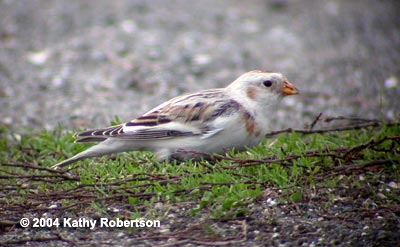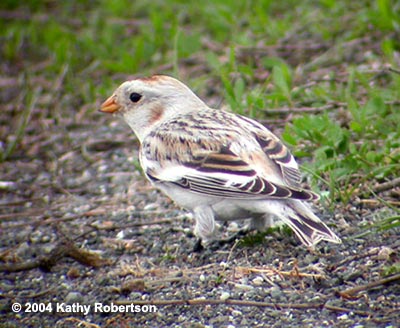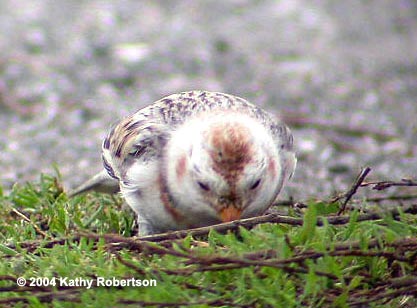Snow Bunting (Plectrophenax
nivalis)
San Leandro, Alameda County, California
26 January 2004
Joseph Morlan
Photos © 26 January 2004 by Kathy Robertson. All rights reserved.
 Today Dan Singer,
Robbie Fischer and I visited the San Leandro Marina in San Leandro to look for the Snow Bunting which had been
found yesterday by Bob Richmond. We missed the bird in the morning, but thanks to a mid-day BirdBox report from
Kay Loughman, we learned the bird had returned and were able to see it very late this afternoon. We arrived about
4:30pm and learned from Bill Bousman that the bird had disappeared about five minutes before we arrived. We continued
to look for it when Robbie radioed me that Debbie Wong had relocated the bird. I was at the north end of the par
course when the call came, and sprinted to the site near par course # 15. There I quickly viewed the bird foraging
on the lawn unconcerned by dogs, joggers or birders. The light was fading, but we were able to observe the bird
at close range through scopes for about 20 minutes before it flushed into the darkness. I attempted to digiscope
the bird in the low light, with the rather grainy results below.
Today Dan Singer,
Robbie Fischer and I visited the San Leandro Marina in San Leandro to look for the Snow Bunting which had been
found yesterday by Bob Richmond. We missed the bird in the morning, but thanks to a mid-day BirdBox report from
Kay Loughman, we learned the bird had returned and were able to see it very late this afternoon. We arrived about
4:30pm and learned from Bill Bousman that the bird had disappeared about five minutes before we arrived. We continued
to look for it when Robbie radioed me that Debbie Wong had relocated the bird. I was at the north end of the par
course when the call came, and sprinted to the site near par course # 15. There I quickly viewed the bird foraging
on the lawn unconcerned by dogs, joggers or birders. The light was fading, but we were able to observe the bird
at close range through scopes for about 20 minutes before it flushed into the darkness. I attempted to digiscope
the bird in the low light, with the rather grainy results below.  Kathy Robertson's excellent photos were
taken earlier in the afternoon.
Kathy Robertson's excellent photos were
taken earlier in the afternoon.
I did not take written plumage notes at the time; the following description is based on memory and on reference
to the photos:
Description
It was a plump, largely white sparrow-like bird, that foraged in a hunkered manner, shuffling on the ground
on the edges of the par course lawn. The head and body were mostly white with a burnt-chestnut patch on the crown
that narrowed to point on the forehead. Chestnut-brown patches were visible at the rear of the ear coverts and
a broad, distinct dark-chestnut band extended across the breast to the bend of the wings. Some photos seem to show
the band as complete, but my recollection is that the band appeared broken mid-breast. The back was grayish with
black streaks, but the rump and uppertail coverts were whitish with a suffusion of tawny brown. The wings were
gray with a conspicuous white area on the outer greater coverts connecting to white inner secondaries. I particularly
noted that the primary coverts appeared completely black. The primary projection was quite long and the primaries
were black with white fringes. The tertials were black with broad chestnut-brown fringes. The tail was black with
extensive white outer edges. The short,  thick bill was a bright candy-corn orange color. The legs appeared dusky. The bird flew
short distances several times showing big white trapezoidal shaped patches in flight. I did not hear any vocalizations.
thick bill was a bright candy-corn orange color. The legs appeared dusky. The bird flew
short distances several times showing big white trapezoidal shaped patches in flight. I did not hear any vocalizations.
Discussion
This is the second Alameda County record for Snow Bunting. I found the first at Bay Farm Island, Alameda, on
2 December 1972. That bird remained until 11 January 1973. The vast majority of California records fall between
22 October and the end of November with few December and January records and two old records extending as late
as mid-February.
Aging and sexing Snow Buntings is a complex task because of the similarity of immature males to females. This
individual was reported to be an adult male. However, I'm inclined to think it is probably a female because of
the completely black primary coverts. The grayish back with black streaks also suggests a female acquiring breeding
plumage.
Additional photos © 26 January 2004 by Joseph Morlan.
All rights reserved.
The dim light made photography very challenging. The photos on the left were taken through the scope, but the photo
on the right was taken with the camera alone at 3x and flash while I was very close to the bird.
 Today Dan Singer,
Robbie Fischer and I visited the San Leandro Marina in San Leandro to look for the Snow Bunting which had been
found yesterday by Bob Richmond. We missed the bird in the morning, but thanks to a mid-day BirdBox report from
Kay Loughman, we learned the bird had returned and were able to see it very late this afternoon. We arrived about
4:30pm and learned from Bill Bousman that the bird had disappeared about five minutes before we arrived. We continued
to look for it when Robbie radioed me that Debbie Wong had relocated the bird. I was at the north end of the par
course when the call came, and sprinted to the site near par course # 15. There I quickly viewed the bird foraging
on the lawn unconcerned by dogs, joggers or birders. The light was fading, but we were able to observe the bird
at close range through scopes for about 20 minutes before it flushed into the darkness. I attempted to digiscope
the bird in the low light, with the rather grainy results below.
Today Dan Singer,
Robbie Fischer and I visited the San Leandro Marina in San Leandro to look for the Snow Bunting which had been
found yesterday by Bob Richmond. We missed the bird in the morning, but thanks to a mid-day BirdBox report from
Kay Loughman, we learned the bird had returned and were able to see it very late this afternoon. We arrived about
4:30pm and learned from Bill Bousman that the bird had disappeared about five minutes before we arrived. We continued
to look for it when Robbie radioed me that Debbie Wong had relocated the bird. I was at the north end of the par
course when the call came, and sprinted to the site near par course # 15. There I quickly viewed the bird foraging
on the lawn unconcerned by dogs, joggers or birders. The light was fading, but we were able to observe the bird
at close range through scopes for about 20 minutes before it flushed into the darkness. I attempted to digiscope
the bird in the low light, with the rather grainy results below.  Kathy Robertson's excellent photos were
taken earlier in the afternoon.
Kathy Robertson's excellent photos were
taken earlier in the afternoon. thick bill was a bright candy-corn orange color. The legs appeared dusky. The bird flew
short distances several times showing big white trapezoidal shaped patches in flight. I did not hear any vocalizations.
thick bill was a bright candy-corn orange color. The legs appeared dusky. The bird flew
short distances several times showing big white trapezoidal shaped patches in flight. I did not hear any vocalizations.

